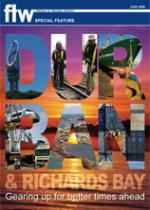It is probably true to say that never
before has quite so much effort and
money gone into the development
of an existing port in this country as
is currently under way at Durban.
Although they are listed as
separate projects, most of the recent
developments have been taking place
at the same time or close behind
each other and should be seen in
their entirety.
The mammoth task of widening
and deepening the harbour entrance
is possibly the most noteworthy
of the projects and certainly the
most visible, as it has had a major
effect on public activity in the
harbour area.
Interestingly it has also been the
project receiving probably the least
concern from environmental interests
and other potential objectors. The
work has been able to progress
without any noticeable delays,
although the pirates of Somali
have done their bit by hijacking a
special side stone dumping vessel,
the Pompei, while it was en route to
Durban to work on the breakwaters.
The Pompei was seized and remains
in pirate hands as this article is being
prepared.
Nevertheless it appears the
channel project will be completed
on schedule by early 2010 and, as
if to confirm this, the first ship to
make official use of the now widened
channel did so on Monday,
June 15, 2009.
In summary the work has entailed
removing the old north pier,
erected from the 1850s onwards,
and reconstructing a new north
breakwater some hundred metres
northward. This involved removing
buildings and other infrastructure at
the tip of the Point which included
some famous watering holes offering
the finest close-up views of shipping
anywhere on the South African coast.
Also removed was the city’s sand
pumping station, which has been in
existence since the early 1980s to
control the loss of beach sand along
Durban’s famous Golden Mile – a
direct result of the port entrance
breakwaters interrupting the
littoral drift. The scheme involved
transferring sand by Transnet
dredger from the Cave Rock bight
outside the north breakwater and
transferring it into a pumping station
on the old north breakwater from
where sand was pumped along the
beaches. With the north breakwater
having to be rebuilt northwards, this
scheme had to be redesigned as part
of the overall project.
Reconstruction of tunnel
Yet another project involving
cooperation between Transnet and
the eThekwini Municipality was
the removal and reconstruction of a
tunnel beneath the entrance channel
to carry service equipment, pipes and
cables to the Bluff. This was carried
out and completed early in
the project.
During all this construction
the entrance channel remained in
regular service, with the minimum of
interruption. The project is costing
an estimated R4 billion – that’s the
amount that was raised with the
Japanese Bank for International
Cooperation in March 2009 to pay
for the project.
One of the highlights marking
the completion of the new channel,
even in an unofficial capacity, will
undoubtedly be the arrival in Durban
in March of the giant luxury cruise
ship Queen Mary 2. With a length
of 345 metres and a beam of over
41m, the huge ship will have no more
problems sailing majestically into
port than did her predecessor QE2.
It is equally exciting for the port
because it means that larger new
generation container ships can now
enter Durban harbour with every
safety, along with the larger bulkers
and tankers. The early engineers who
battled to build the first breakwaters
would be impressed.
Harbour entrance developments help redefine Durban Bay
25 Jun 2009 - by Terry Hutson
0 Comments
Durban & Richards Bay 2009

25 Jun 2009
25 Jun 2009
25 Jun 2009
25 Jun 2009
25 Jun 2009
25 Jun 2009
25 Jun 2009
25 Jun 2009
25 Jun 2009
Border Beat
Poll
Featured Jobs
New
New
